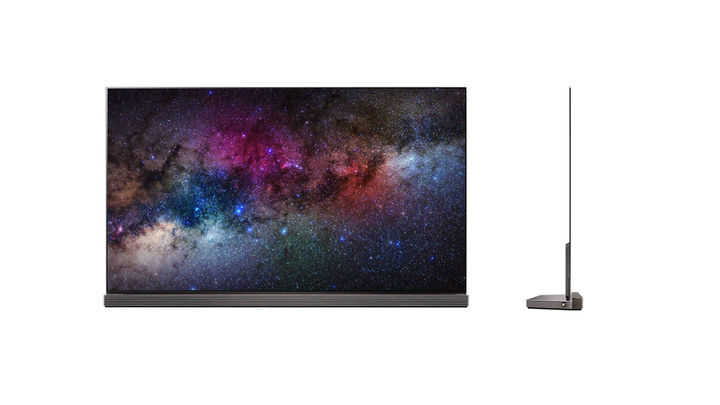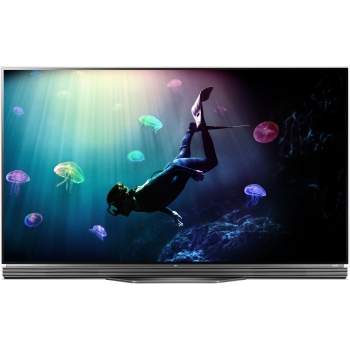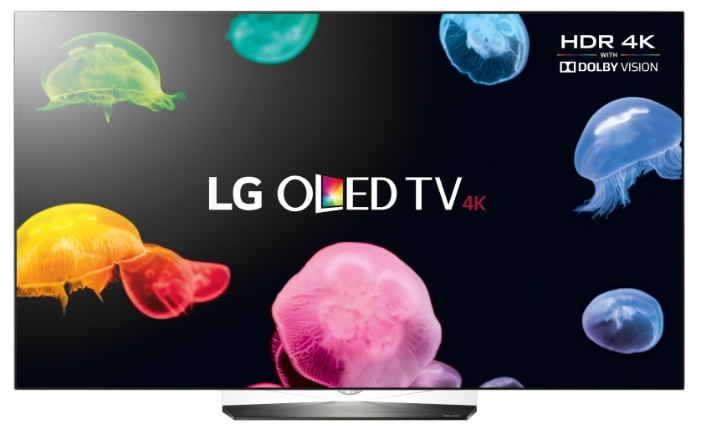2019 OLED TVs still delight their customers with an ultra-slim body and impeccable image quality. LG, being the first manufacturer to introduce OLED technology, continues to bet on the production of panels with organic LEDs with a resolution of 4K.

Content
A bit about OLED technology
What is this technology? Why is it interesting and what are the advantages of OLED TVs over LCD?
The acronym OLED stands for Organic Light Emitting Diode - Organic Luminous Diode. If electric current is passed through organic LEDs, they emit a bright glow. Using phosphors shining with specific colors: red, blue and green, combining them with a combination, you can get a huge number of different colors and shades.
The OLED panel is based on a matrix with organic luminous diodes, the use of which demonstrate the clear advantages of this technology over others:
- lack of need for backlighting of the screen saves space in the TV case, which makes it thin and light;
- the power consumption of such TVs is 40% less;
- thanks to unusual diodes, the viewing angle of the matrices is very large: viewers watch television with the same comfort, regardless of the viewing angle;
- image quality does not suffer when broadcasting dynamic scenes due to the fast response of the matrix elements, the color change occurs at lightning speed;
- high level of contrast and brightness.
Along with the obvious advantages of OLED panels, unfortunately, there are also disadvantages:
- the fragility, which is determined by the life of the organic LEDs: green and red - tens of thousands of hours, and blue - about eighteen thousand hours, subject to continuous operation, that is, about two years;
- very expensive technology compared to LCD TVs with a similar screen size.
Manufacturers are actively working to increase the performance and life of the phosphors. So, in the long term, a pleasant event awaits buyers: the production of OLED TVs with a large diagonal should become much cheaper than LCD panels.
Features of the new LG TVs
In recent years, LG has gained fame as the most innovative company among manufacturers of television equipment. This is an obvious fact - today only LG produces OLED panels. LG is the undisputed leader in the production of OLED TVs in 2019.
Although other companies also produce OLED TVs, they use LG displays.
In the presented review from the company LG there are four lines with support for HDR.
- The flagship G6 range includes SIGNATURE flat panels with diagonals of 65 and 77 inches. Their feature is:
- incredibly thin cases, the thickness of which is only 2.57 mm;
- framed by an OLED matrix with a glass frame, representing the original design "picture on glass";
- Harman / K Certified SoundBar
The cost of the 77-inch panel is about $ 20,000.
The cost of the 65-inch panel is about $ 8,000.

- In second place is the E6 line, which contains two models: 65 and 55 inches. Outwardly, the E6 series is similar to the G6, since it is also made of glass, the difference in the sound system is the 2.2 format speakers with a power of 60 watts.
The cost of the model from the E6-series with a 65-inch diagonal is $ 7,000.

- The C6 series is equipped with high-profile curved OLED panels last season. In this series, two models are presented: 65 and 55 inches. Curved screens, having not been in the trend for long, have lost the interest of buyers. Manufacturers abandoned curved panels, relying on classic screens.

- The LG B6 line is presented by budget OLED TVs with flat screens with Ultra HD resolution. In this series, two models with 55 and 65 inch diagonals are produced.
The cost of the 65-inch model of the B6-series is $ 6,000, and the 55-inch model costs $ 4,000.

As can be seen from the presented review, the price of ice TVs in 2019 is still unavailable to the general public.
Four LG models: 55E6, 65E6, 65G6 and 77G6 passed UHDA certification and received the UltraHD Premium logo.
All presented new LG OLED TVs support HDR and Dolby Vision HDR standards.
Sony: OLED panel + speaker
Sony was the first manufacturer of television equipment to begin the development and production of OLED displays. The first developed 11-inch screen with a thickness of 0.2 mm was announced back in 2008.
But in 2014, the production of OLED matrices was frozen - the company relied on 4K ULTRA HD LCD TVs. There was an agreement between Sony and Panasonic on the joint production of OLED displays, which was subsequently terminated. The produced OLED TVs use matrices from LG.
In the review of the CES-2017 exhibition, among the presented models, Sony's new products could not go unnoticed. New TVs supporting 4K HDR under the brand name “Bravia OLED” were presented by the A1E series.

New items are unique in their sound system - the screen is also a speaker at the same time.
The innovative Acoustic Surface technology was developed by Sony based on the design of the OLED display, which, receiving signals from tiny speakers, amplifies the sound with vibration and transmits it to the entire surface of the screen.
This unique technology provides unprecedented synchronization of image and sound. Image and sound are perceived as a whole, which is completely unattainable in other TVs.
Models in the A1E series are equipped with OLED arrays, which contain about 8 million luminescent pixels. TVs deliver amazingly realistic, colorful images with high contrast and wide viewing angles.
The matrix control with a huge number of elements is carried out by the X1 Extreme processor with the highest accuracy, improving the transmission of 4K HDR images.
The design of all three announced models with diagonals of 55, 65 and 77 inches is the same:
- a large screen framed by a barely noticeable frame;
- minimum thickness;
- lack of any details;
- all elements of the hardware filling are “hidden” in the side stand.
Conclusion
Despite the bright advantages of OLED panels, experts are pessimistic about the future of LED technology in the production of TVs.
Doubts cause a short service life of organic LEDs and high cost.
Perhaps manufacturers will please us with new discoveries and developments?
Wait and see.



